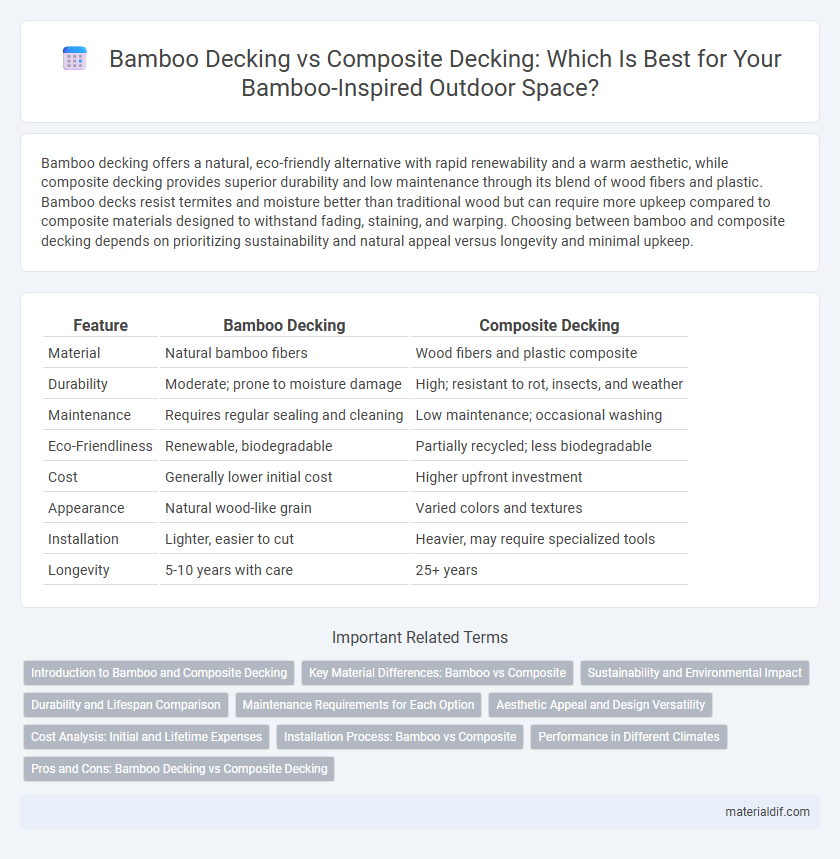Bamboo decking offers a natural, eco-friendly alternative with rapid renewability and a warm aesthetic, while composite decking provides superior durability and low maintenance through its blend of wood fibers and plastic. Bamboo decks resist termites and moisture better than traditional wood but can require more upkeep compared to composite materials designed to withstand fading, staining, and warping. Choosing between bamboo and composite decking depends on prioritizing sustainability and natural appeal versus longevity and minimal upkeep.
Table of Comparison
| Feature | Bamboo Decking | Composite Decking |
|---|---|---|
| Material | Natural bamboo fibers | Wood fibers and plastic composite |
| Durability | Moderate; prone to moisture damage | High; resistant to rot, insects, and weather |
| Maintenance | Requires regular sealing and cleaning | Low maintenance; occasional washing |
| Eco-Friendliness | Renewable, biodegradable | Partially recycled; less biodegradable |
| Cost | Generally lower initial cost | Higher upfront investment |
| Appearance | Natural wood-like grain | Varied colors and textures |
| Installation | Lighter, easier to cut | Heavier, may require specialized tools |
| Longevity | 5-10 years with care | 25+ years |
Introduction to Bamboo and Composite Decking
Bamboo decking offers a sustainable, eco-friendly alternative to traditional materials with its rapid growth and natural durability, making it resistant to moisture and insects. Composite decking, made from recycled wood fibers and plastic, combines low maintenance with high resistance to fading, staining, and cracking, ideal for long-lasting outdoor surfaces. Both options provide visually appealing finishes and durability, but bamboo stands out for its renewable resource benefits while composite excels in requiring minimal upkeep.
Key Material Differences: Bamboo vs Composite
Bamboo decking is made from natural bamboo fibers, offering a renewable resource with high tensile strength and resistance to moisture when properly treated, whereas composite decking consists of a mixture of wood fibers and plastic resins designed for durability and low maintenance. Bamboo's natural composition provides eco-friendly benefits and a warm aesthetic, while composite decking typically incorporates UV stabilizers and antimicrobial agents to enhance longevity and prevent fading. The density and cellular structure of bamboo contribute to its hardness and resilience, contrasting with composite's engineered consistency and variability depending on the wood-plastic ratio.
Sustainability and Environmental Impact
Bamboo decking offers exceptional sustainability due to its rapid growth rate, reaching maturity in 3-5 years, which significantly reduces deforestation compared to traditional hardwoods used in composite decking. Unlike composite decking that contains plastics and resins derived from fossil fuels, bamboo decking is biodegradable and produces minimal carbon emissions during processing. The renewable nature of bamboo coupled with its low environmental footprint makes it a superior eco-friendly choice for sustainable outdoor flooring solutions.
Durability and Lifespan Comparison
Bamboo decking offers impressive durability due to its natural hardness and resistance to wear, typically lasting 20 to 25 years with proper maintenance. Composite decking, made from a blend of wood fibers and plastic, provides superior resistance to moisture, rot, and insect damage, extending its lifespan often beyond 30 years. While bamboo decking requires more upkeep to preserve its structural integrity, composite decking delivers longer-lasting performance with minimal maintenance.
Maintenance Requirements for Each Option
Bamboo decking requires regular sealing and occasional sanding to maintain its natural appearance and prevent moisture damage, especially in humid environments. Composite decking demands minimal maintenance, needing only periodic cleaning with soap and water to resist fading, staining, and mold growth. Both options offer durable surfaces, but bamboo requires more upkeep to preserve its aesthetic and structural integrity over time.
Aesthetic Appeal and Design Versatility
Bamboo decking offers a natural, warm aesthetic with distinctive grain patterns that bring an organic and eco-friendly charm to outdoor spaces. Composite decking, made from a blend of wood fibers and plastic, provides a wider range of colors, textures, and finishes, allowing for more customizable design options and a modern look. Both materials enhance design versatility, but bamboo excels in delivering a sustainable, natural beauty, while composite decking supports bold, contemporary designs with low maintenance requirements.
Cost Analysis: Initial and Lifetime Expenses
Bamboo decking typically offers a lower initial cost compared to composite decking, making it an attractive option for budget-conscious homeowners. While bamboo requires regular maintenance such as sealing and sanding to prevent weathering and extend its lifespan, composite decking demands less upkeep, reducing ongoing maintenance expenses over time. Despite higher upfront costs, composite decking often proves more cost-effective long-term due to its durability and resistance to rot, mold, and insect damage.
Installation Process: Bamboo vs Composite
Bamboo decking installation typically involves cutting and fixing bamboo planks with screws or nails onto a prepared subframe, offering a natural, lightweight material that is easy to handle. Composite decking requires precise alignment of interlocking boards or panels, often with hidden fasteners, ensuring durable and low-maintenance surfaces resistant to warping and insect damage. Bamboo installation may be faster due to the material's flexibility, whereas composite demands careful handling for proper expansion and contraction accommodation.
Performance in Different Climates
Bamboo decking offers excellent natural resistance to moisture and moderate temperature fluctuations, making it suitable for humid and tropical climates. Composite decking boasts superior durability against UV rays, extreme cold, and heavy rainfall due to its synthetic materials and protective coatings. In regions with harsh winters or intense sun exposure, composite decking tends to maintain its structural integrity and color better than bamboo.
Pros and Cons: Bamboo Decking vs Composite Decking
Bamboo decking offers a sustainable, eco-friendly alternative with natural aesthetics and rapid renewability but can be prone to moisture absorption and requires regular maintenance. Composite decking boasts superior durability, resistance to rot, and low maintenance needs, yet it often comes with higher upfront costs and less natural appearance. Both materials present distinct benefits and drawbacks depending on budget considerations, environmental priorities, and desired longevity.
bamboo decking vs composite decking Infographic

 materialdif.com
materialdif.com